2024. November 21. Thursday
Museum Piece Compilation of the Soma Orlai Petrics Cultural Center - Mezőberény
 |
Address: 5650, Mezőberény Fő út 1-3.
Phone number: (20) 225-4846
E-mail: opsgy@mbereny.hu
Opening hours: Tue, Fri 10-12, Wed, Thu 14-16
|
Museum tickets, service costs:
|
Ticket for adults
|
220 HUF
|
|
|
Ticket for students
|
110 HUF
|
|
|
Ticket for pensioners
|
110 HUF
|
|
|
Guide
|
500 HUF
|
We remembered the 280 anniversary of the repopulation of the town in 2003. The new permanent exhibition titled 'Living Together for 280 Years' opened on the occasion. The display presenting the furnishing of the houses of the 19-20th century includes a rich collection of photos and ceramics.

In 2004 the exhibition was extended with clothes shown on dolls. The first ward invites the visitors with the atmosphere of a room from the beginning of the 20th century with contemporary paintings.
Entering the next ward, the audience may see archive photos on the walls. The photos of German, Hungarian and Slovakian families show the cloths of the typical peasant citizen of the 11-20th century. Besides the walls painted chests, wardrobes in the Old German style and the furniture of the richer and poorer peasants can be seen.
Part of the dolls dressed in folk cloths, a German bride and groom, a Slovakian woman in fur coat and a Hungarian man in embroidered felt cloak of Hungarian shepherds are also in these wards. The ceramics are grouped: we show jugs from Mezőtúr, plates from Hódmezővásárhely besides tiles for chimneys. The rack with a coat of arms, a nice piece of the late peasant furniture, was made in 1906. The significant number of plates and bowls suggest their popularity with our ancestors.
In one corner of the last ward, the audience can see the furniture of a Slovakian clean room. A corner shelf is placed over the painted corner bench with hard tile plates with roses on. We also show a wall mirror, a painted crib, carved and painted chairs and a chest with tulip design.
The doll with bride dress on is in this interior. The painted bed with ceiling is also part of the display. The bed is accompanied with embroidered pillows. A civic German furniture is displayed in the other corner. Next to the wardrobe, the bed is covered with a hand crocheted cover. Over the bed, large family photos are placed and a music Luther picture. The details are represented with an Old German mirror and a wooden armchair, as well as a peasant civic cloths from the beginning of the 19th century.
Opposite to these, we placed an service table and a showcase. The last furniture is an old chest with three drawers.

In 2004 the exhibition was extended with clothes shown on dolls. The first ward invites the visitors with the atmosphere of a room from the beginning of the 20th century with contemporary paintings.
Entering the next ward, the audience may see archive photos on the walls. The photos of German, Hungarian and Slovakian families show the cloths of the typical peasant citizen of the 11-20th century. Besides the walls painted chests, wardrobes in the Old German style and the furniture of the richer and poorer peasants can be seen.
Part of the dolls dressed in folk cloths, a German bride and groom, a Slovakian woman in fur coat and a Hungarian man in embroidered felt cloak of Hungarian shepherds are also in these wards. The ceramics are grouped: we show jugs from Mezőtúr, plates from Hódmezővásárhely besides tiles for chimneys. The rack with a coat of arms, a nice piece of the late peasant furniture, was made in 1906. The significant number of plates and bowls suggest their popularity with our ancestors.
In one corner of the last ward, the audience can see the furniture of a Slovakian clean room. A corner shelf is placed over the painted corner bench with hard tile plates with roses on. We also show a wall mirror, a painted crib, carved and painted chairs and a chest with tulip design.
The doll with bride dress on is in this interior. The painted bed with ceiling is also part of the display. The bed is accompanied with embroidered pillows. A civic German furniture is displayed in the other corner. Next to the wardrobe, the bed is covered with a hand crocheted cover. Over the bed, large family photos are placed and a music Luther picture. The details are represented with an Old German mirror and a wooden armchair, as well as a peasant civic cloths from the beginning of the 19th century.
Opposite to these, we placed an service table and a showcase. The last furniture is an old chest with three drawers.
